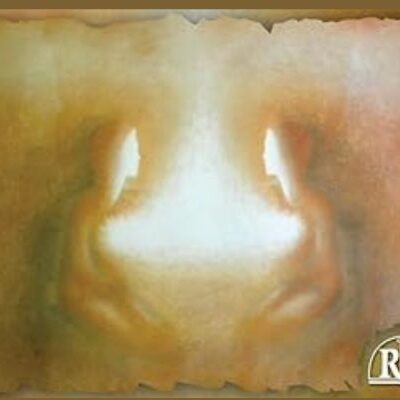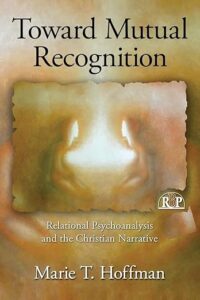
Essential Readings in Integration: Toward Mutual Recognition by Dr. Marie Hoffman
Someone somewhere, and I swear it was David Brooks, said publicly the act of writing is in no small part an act of directing a desert people to water. Like a sojourner the writer stumbles across a small 
And I take a stab here, using an OLOGY reflection to point out water. There are books, papers, and lectures that, I think, illuminate the integrative effort. They collide theologies and psychologies to clarifying—quenching—results. And I start with the work of Dr. Marie Hoffman, author of Toward Mutual Recognition: Relational Psychoanalysis and the Christian Narrative. It is a seminal work of religious and psychological integration, published by Routledge in 2011. So let’s talk about it here.
Dr. Marie Hoffman is herself an interesting subject. As an undergraduate, she studied religion at the famously fundamentalist Bob Jones University in South Carolina. Making pivots into the world of mental health counseling and psychotherapy, she later obtained her master’s degree from Villanova University and a doctorate in clinical psychology from the now-shuttered Union Institute hubbed in Cincinnati. Many years after that, Dr. Marie Hoffman finished postdoctoral training in psychotherapy and psychoanalysis at New York University. Now, in the annuls of psychoanalysis, the NYU postdoc holds a revered place as a progressive and pluralistic training ground drawing the likes of many names immortalized in the field. One must appreciate the trajectory upon which those years set her—Dr. Hoffman remains on adjunct faculty at NYU’s postdoc herself. The winding path Dr. Hoffman walked, across a slew of ideological landscapes, left her a diversity of artifacts—thoroughly religious and secular—from which to draw. These burst forth from her integrative writings and professional initiatives.
Dr. Marie Hoffman and her husband, psychoanalyst Dr. Lowell Hoffman, together founded the Brookhaven Institute for Psychoanalysis and Christian Thought (BIPACT) and the Society for the Exploration of Psychoanalytic Therapies and Theology (SEPTT). And these two represent publications aplenty, all plumbing depths of both psychoanalytic and Christian ideas.
Toward Mutual Recognition stands tall among them. Here she reconnects two islands, contemporary psychoanalysis and Christianity, each popularly presumed at war with the other. By doing so, she confronts her readers with a set of all-of-a-sudden-head-smackingly-obvious resonances. All of a sudden, a new question comes fore. Particularly in its contemporary forms, how could psychoanalysis not reflect crucial elements of the Christian life?
But to begin Dr. Hoffman approaches psychoanalysis, a historically Jewish (but mostly secular) study, humbly. The book springs forth from an impassioned letter Dr. Hoffman writes Dr. Freud on behalf of “a contrite Christian church.” She baldly acknowledges how Freud repudiated religion, but she too names the reactionary projections Christians have for so long slung at Freud and his brethren: subtle dismissal and violent genocide. “We want to revisit psychoanalysis, approaching it with the veil of atheism lifted, with your Judaic subtext in high relief. We wish to contemplate that perhaps, in the mystery of a Jewish and Christian Providence, your works were yet another prophetic clarion call to truth, yet another redemptive outworking of God’s irrevocable covenant with Jew and Gentile.” Quite an introduction to quite a task.
Hoffman then goes about developing a language shared by both Christian and psychoanalytic thought. She seizes the postmodern moment. It is the moment giving way to a “relational turn” in psychoanalysis, in all of life really. It marked the West’s move away from systems of knowledge emphasizing isolated minds, admitting that all life and all knowledge remains socially embedded. In the drift Dr. Hoffman sees opportunity to better justify cooperation between Christianity and psychoanalysis.
Relational psychoanalysis, or even relational psychotherapy in general, developed only recently in the 130 years since Freud.[1] Drs. Jay Greenberg and Stephen Mitchell published one of the watershed books of American psychoanalysis in 1983. Object Relations in Psychoanalytic Theory distinguished models of intervention emphasizing certain drives housed in isolated individuals from those emphasizing pathologies only acted out among relationships (object relations). New models could not help but treat ills as socially embedded. That distinction eventually coalesced around a movement in the late 1980s, termed Relational Psychoanalysis. To this day, it is a movement characterized not so much by the amount of unconscious material “truly” interpreted and made conscious by an objective therapist—as in the olden days. Instead, it underscores the ways a practiced but hapless therapist might reflect with a patient the shared meanings of actions. Problems are created by relationships, and so problems need be fixed in relationships.
And others contributed too, adding new language with which to understanding psychotherapy. Jessica Benjamin, to whom Hoffman acknowledges great debt, writes of mutual recognition: “The capacity to see others as equal subjects with needs, desires, and perspectives that can differ from one’s own, and the reciprocating experience of the other’s acknowledgement of oneself.” Healthy human development, it is proposed, aims squarely at achieving this capacity. And it does so in sequence.
Identification, Surrender, then Differentiation. We first identify another: Mom, dad, neighbor, friend, pastor, whatever. We face the terrifying reality that this other has some mysterious subjectivity, some agency, entirely outside of our control. They might think, feel, and behave in ways that we cannot predict or understand. And we avoid this reality by painting as fully formed a picture of the other as we muster. We assume and we project. But, eventually and painfully, we surrender our preconceptions to the reality that, well, they are who they are. If we can survive, even through disappointment, we achieve hard-won differentiation. We can even appreciate the unique contours of the other’s subjectivity. To play this out in relational therapy is, so the theory goes, profoundly healing.
Dr. Hoffman lays these ideas as bricks along the bridge, mirroring the Christian story. Here Identification, Surrender, and Differentiation, translate to Incarnation, Crucifixion, and Resurrection. Christ steps into human form as God incarnate, in essence allowing us to paint him as he pleases. But gradually Jesus’ ministry takes shape, and he frustrates and confounds. No longer tolerating the disappointments, we crucify him. But Jesus survives violent projection, resurrecting a new reality that leaves redemption in its wake. The story plays and replays. And to play at it in therapy is not just profoundly healing, it is profoundly pastoral.
Once one takes a fuller understanding of these ideas, they can be readily applied to so many elements of religious life. Take prayer, for example. Prayer, that sacred conversation with the divine, follows a similar cycle: Identification, Surrender, Differentiation; Incarnation, Crucifixion, Resurrection. And where one, let’s say, gets stuck in the cycle can reveal much about one’s journey towards mutual recognition. There is a lot of psychological fodder to be found here.
And it just so happens, too, that Drs. Marie and Lowell Hoffman serve as the first speakers in this year’s OLOGY series on prayer. Blending psychodynamic theory with Christian theologies, the Hoffmans will speak to the psychological significance of prayer in ways only they can. They present The God who is There: Development of the Capacity of Prayer for Therapist and Patient. So if you are interested in discussing further, please do register and join us. You will leave grateful.
[1] We say this, but Freud’s friend and contemporary, Sandor Ferenczi, was planting the seeds a long time ago. Psychoanalytic theorists recognize this retrospectively. Harry Stack Sullivan was doing something similar, later, in America.
